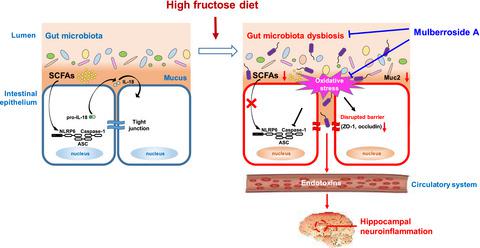当前位置:
X-MOL 学术
›
J. Neurochem.
›
论文详情
Our official English website, www.x-mol.net, welcomes your feedback! (Note: you will need to create a separate account there.)
Mulberroside A repairs high fructose diet-induced damage of intestinal epithelial and blood–brain barriers in mice: A potential for preventing hippocampal neuroinflammatory injury
Journal of Neurochemistry ( IF 4.7 ) Pub Date : 2020-11-18 , DOI: 10.1111/jnc.15242 Rong Yu 1 , Shiyu Wen 1 , Qiaona Wang 1 , Congying Wang 1 , Liping Zhang 1 , Xingxin Wu 1 , Jianmei Li 1 , Lingdong Kong 1
Journal of Neurochemistry ( IF 4.7 ) Pub Date : 2020-11-18 , DOI: 10.1111/jnc.15242 Rong Yu 1 , Shiyu Wen 1 , Qiaona Wang 1 , Congying Wang 1 , Liping Zhang 1 , Xingxin Wu 1 , Jianmei Li 1 , Lingdong Kong 1
Affiliation

|
Our previous studies showed that high fructose diet (HFrD)-driven gut dysbiosis caused fecal short-chain fatty acids (SCFAs) reduction and intestinal epithelial barrier (IEB) damage in mice, which might play an important role in hippocampal neuroinflammatory injury. Mulberroside A is reported to have neuroprotective effects in animal experiments, while the underlying mechanisms are not yet fully elucidated. Here, we investigated whether and how mulberroside A prevented HFrD-induced neuroinflammatory injury. HFrD-fed mice were treated orally with mulberroside A (20 and 40 mg/kg) for 8 weeks. Mulberroside A was found to inhibit hippocampal neuroinflammation and neurogenesis reduction in HFrD-fed mice. It reshaped gut dysbiosis, increased fecal and serum SCFAs contents, reactivated signaling of the colonic NLR family, pyrin domain containing 6 (NLRP6) inflammasome, and up-regulated Muc2 expression to prevent IEB damage, as well as subsequently, reduced serum endotoxin levels in this animal model. Additionally, mulberroside A inhibited oxidative stress in colon of HFrD-fed mice and hydrogen peroxide (H2O2)-stimulated Caco-2 cells. Blood–brain barrier (BBB) structure defects were also observed in HFrD-driven hippocampal neuroinflammatory injury of mice. Interestingly, mulberroside A maintained astrocyte morphology and up-regulated tight junction proteins to repair BBB structure defects in hippocampus dentate gyrus (DG). Our results demonstrated that mulberroside A was capable of preventing HFrD-induced damage of IEB and BBB in mice, which might contribute to the suppression of hippocampal neuroinflammatory injury.
中文翻译:

Mulberroside A 修复高果糖饮食诱导的小鼠肠上皮和血脑屏障损伤:预防海马神经炎症损伤的潜力
我们之前的研究表明,高果糖饮食 (HFrD) 驱动的肠道菌群失调导致小鼠粪便短链脂肪酸 (SCFA) 减少和肠上皮屏障 (IEB) 损伤,这可能在海马神经炎症损伤中起重要作用。据报道,桑葚苷 A 在动物实验中具有神经保护作用,但其潜在机制尚未完全阐明。在这里,我们研究了桑树苷 A 是否以及如何预防 HFrD 诱导的神经炎症损伤。HFrD 喂养的小鼠用桑葚苷 A(20 和 40 毫克/千克)口服治疗 8 周。发现 Mulberroside A 抑制 HFrD 喂养小鼠的海马神经炎症和神经发生减少。它重塑肠道生态失调,增加粪便和血清 SCFAs 含量,重新激活结肠 NLR 家族的信号,pyrin 结构域含有 6 (NLRP6) 炎症小体,并上调 Muc2 表达以防止 IEB 损伤,以及随后降低该动物模型中的血清内毒素水平。此外,桑树苷 A 抑制了 HFrD 喂养小鼠结肠中的氧化应激和过氧化氢(H2 O 2 )-刺激的 Caco-2 细胞。在 HFrD 驱动的小鼠海马神经炎症损伤中也观察到血脑屏障 (BBB) 结构缺陷。有趣的是,桑树苷 A 维持星形胶质细胞形态并上调紧密连接蛋白以修复海马齿状回 (DG) 中的 BBB 结构缺陷。我们的研究结果表明,桑椹苷 A 能够预防 HFrD 诱导的小鼠 IEB 和 BBB 损伤,这可能有助于抑制海马神经炎症损伤。
更新日期:2020-11-18
中文翻译:

Mulberroside A 修复高果糖饮食诱导的小鼠肠上皮和血脑屏障损伤:预防海马神经炎症损伤的潜力
我们之前的研究表明,高果糖饮食 (HFrD) 驱动的肠道菌群失调导致小鼠粪便短链脂肪酸 (SCFA) 减少和肠上皮屏障 (IEB) 损伤,这可能在海马神经炎症损伤中起重要作用。据报道,桑葚苷 A 在动物实验中具有神经保护作用,但其潜在机制尚未完全阐明。在这里,我们研究了桑树苷 A 是否以及如何预防 HFrD 诱导的神经炎症损伤。HFrD 喂养的小鼠用桑葚苷 A(20 和 40 毫克/千克)口服治疗 8 周。发现 Mulberroside A 抑制 HFrD 喂养小鼠的海马神经炎症和神经发生减少。它重塑肠道生态失调,增加粪便和血清 SCFAs 含量,重新激活结肠 NLR 家族的信号,pyrin 结构域含有 6 (NLRP6) 炎症小体,并上调 Muc2 表达以防止 IEB 损伤,以及随后降低该动物模型中的血清内毒素水平。此外,桑树苷 A 抑制了 HFrD 喂养小鼠结肠中的氧化应激和过氧化氢(H2 O 2 )-刺激的 Caco-2 细胞。在 HFrD 驱动的小鼠海马神经炎症损伤中也观察到血脑屏障 (BBB) 结构缺陷。有趣的是,桑树苷 A 维持星形胶质细胞形态并上调紧密连接蛋白以修复海马齿状回 (DG) 中的 BBB 结构缺陷。我们的研究结果表明,桑椹苷 A 能够预防 HFrD 诱导的小鼠 IEB 和 BBB 损伤,这可能有助于抑制海马神经炎症损伤。

























 京公网安备 11010802027423号
京公网安备 11010802027423号